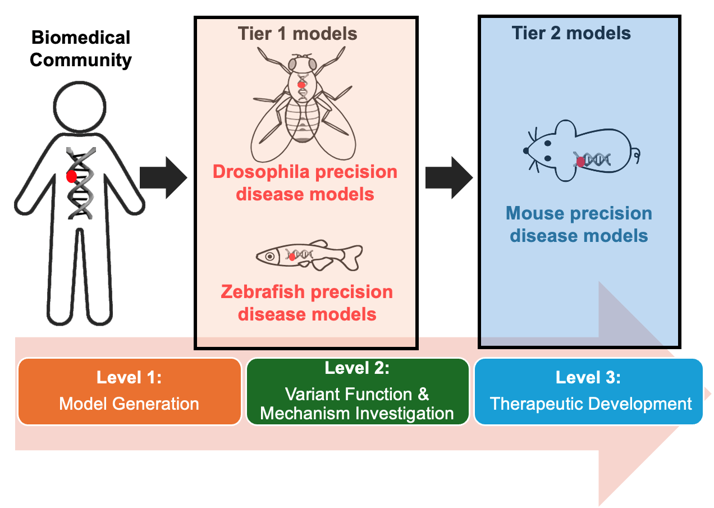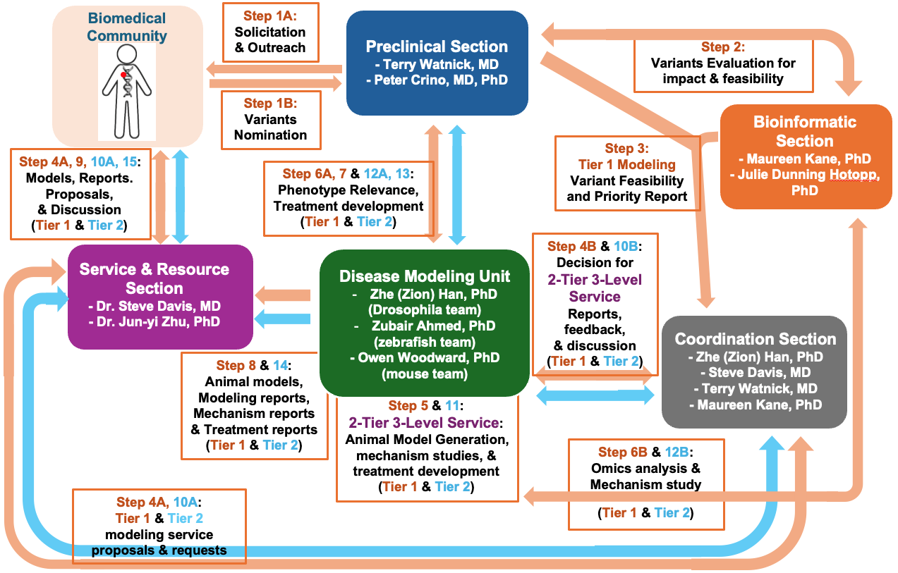“2-Tier 3-Level” Service Strategy Maximizes Capacity and Impact at CPDM@UMB

CPDM@UMB’s innovative “2-Tier 3-Level” strategy maximizes precision modeling efficiency, meets diverse user needs, and supports translational research (Fig. 2). This approach integrates Drosophila, zebrafish, and mouse models into a streamlined framework for rapid, large-scale variant analysis with rigorous validation and preclinical relevance.
Tier 1: Functional Studies & Precision Models (Drosophila & Zebrafish)
- Level 1: Generate precision models using Drosophila and zebrafish.
- Level 2: Conduct phenotypic and multi-omics analyses to uncover disease mechanisms.
- Level 3: Develop and test mechanism-based therapeutics.
Tier 1 enables rapid, cost-effective analysis of large numbers of community-nominated variants, accelerating disease mechanism discovery and treatment development.
Tier 2: Validation & Preclinical Studies (Mouse Models)
- Level 1: Generate precision models using CRISPR knock-in mouse models.
- Level 2: Perform phenotypic and omics analyses to study mechanisms.
- Level 3: Develop and test mechanism-based therapeutics.
Tier 2 builds on Tier 1 findings, advancing them to mouse models for rigorous validation and preclinical testing, ensuring translational relevance and clinical impact.
Overall Workflow of the “2-Tier 3-Level” Service Strategy at CPDM@UMB

Since 2019, CPDM@UMB has refined its precision disease modeling service into a streamlined 15-step “2-Tier 3-Level” workflow to maximize efficiency and impact. This approach supports high-throughput precision disease modeling and translational research to address the diverse needs of the biomedical community.
Steps 1–4: Variant Nomination, Prioritization, and Service Proposal
1. Variant Nomination: Submissions from clinicians, geneticists, and consortia through outreach and a submission form on our website.
2. Evaluation: The Preclinical Section assesses clinical significance (e.g., allele frequency, genotype-phenotype correlation), while the Bioinformatics Section evaluates modeling feasibility (e.g., gene homology, expression).
3. Priority Report: A combined “Variant Feasibility and Priority Report” is submitted to the Coordination Section for review.
4. Service Proposal: If approved, a “Tier 1 Precision Modeling Service Proposal” is sent to the user for feedback, which finalizes the request and allows the Disease Modeling Unit (DMU) to proceed with Tier 1 Level 1 (T1L1) service.
Steps 5–9: Tier 1 Precision Modeling Services
5. Model Generation: The DMU creates Tier 1 models using Drosophila or zebrafish.
6. Phenotypic Analysis: The DMU collaborates with the Preclinical Section for phenotypic assays (T1L2) and with the Bioinformatics Section for multi-omics studies if needed.
7. Therapeutic Testing: The DMU and Preclinical Section test mechanism-based therapies (T1L3).
8. Report Preparation: The DMU compiles model generation, phenotypic analysis, and treatment development reports.
9. Model Transfer: Models and reports are transferred to the Service & Resource Section for distribution and user feedback.
Steps 10–15: Tier 2 Precision Modeling Services
10. Tier 2 Proposal: If Tier 1 results are promising, the DMU prepares a Tier 2 proposal for mouse models, which is reviewed by the Coordination Section and Steering Committee.
11. Mouse Model Generation: The DMU generates Tier 2 mouse models.
12. Phenotypic and Multi-Omics Studies: The DMU conducts phenotypic analysis (T2L2) and multi-omics studies if needed.
13. Therapeutic Testing: The DMU and Preclinical Section test therapies (T2L3).
14. Report Preparation: The DMU compiles reports on model generation, phenotypic analysis, and therapy testing.
15. Model Transfer: Models and reports are managed and distributed by the Service & Resource Section.
This structured 15-step workflow ensures a flexible, efficient pipeline for precision disease modeling, mechanism discovery, and therapy development, positioning CPDM@UMB as a leader in translational research and precision medicine.
